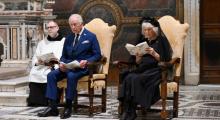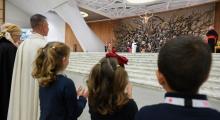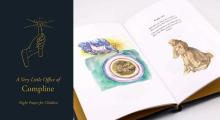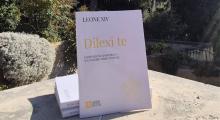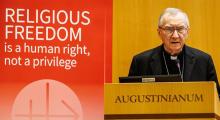Issued by the Catholic Center for Studies and Media - Jordan. Editor-in-chief Fr. Rif'at Bader - موقع أبونا abouna.org
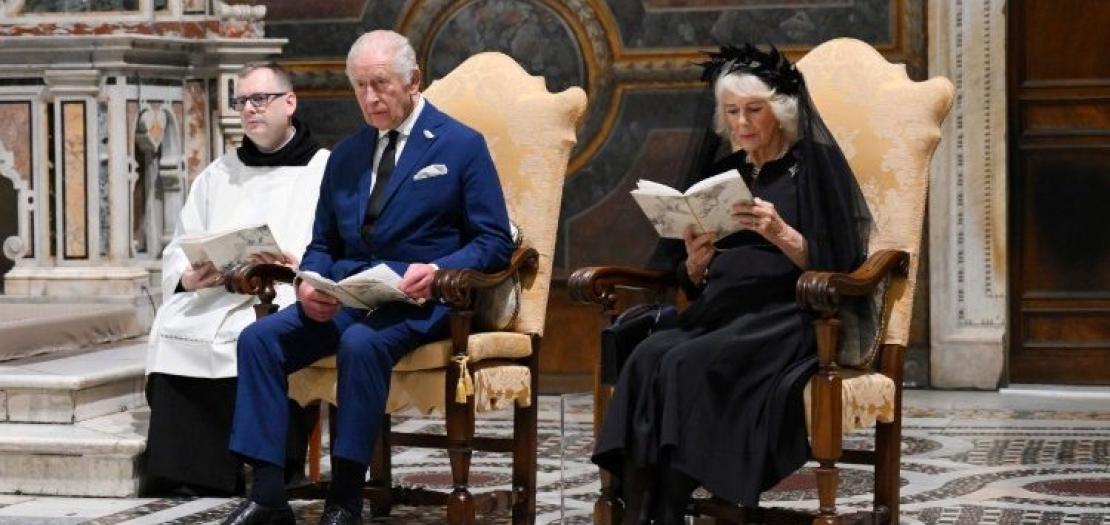
On Thursday, October 23, Pope Leo XIV participated in various events with King Charles III and Queen Camilla, including an ecumenical prayer in the Sistine Chapel, marking a historic moment in Anglican-Catholic relations.
The day included a private meeting between the two leaders in the Apostolic Palace and an ecumenical service in the Basilica of Saint Paul Outside the Walls, where King Charles was conferred the title of Royal Confrater of Saint Paul.
Father Martin Browne, an Irish Benedictine monk and official of the Dicastery for Promoting Christian Unity, whose work focuses on the Church’s relationship with the Anglican Communion, spoke to Vatican News' Xavier Sartre about some of the main elements of this historic day, especially the ecumenical aspects and the unifying theme of the care for creation.
“One of the most significant things is that an English King has not prayed in the same place as a Pope since before the Reformation, since long before the separation of the Church of England from the Church of Rome,” said Father Browne.
Despite many English sovereigns having visited the Vatican, the last time they prayed with a Pope was 500 years ago. This historical event thus marks a “further development in the warmth of the relationship” between the two Churches, Father Browne continued.
The afternoon service in the Basilica of St. Paul Outside the Walls also represents the inauguration of “a new kind of relationship between the Basilica and the English crown”.
With the King becoming a Royal Confrater, he was "welcomed formally to the Basilica and seated in a very special chair that has been created for the occasion,” which bears his coat of arms and the verse in Latin from the Gospel of John, Ut unum sint (“That they may be one”).
“Traditionally, before the Reformation, the English sovereigns were known as the protectors of St. Paul's Outside the Walls. The Benedictine Abbey to this day still has a symbol of the British Order of the Garter, which is the highest order in the United Kingdom, as part of its coat of arms,” Father Browne said.
The Vatican official underlined that, since King Charles III also holds the title of “Supreme Governor of the Church of England,” he wanted to have a “spiritual dimension” to his trip, despite it being a state visit to the Holy See.
For Father Browne, the King “clearly wished to express a closeness that he believes already exists and to make that concrete and visible” through the various events.
Additionally, both Pope Francis—with whom the ecumenical prayer had initially been scheduled in April but had to be postponed due to his ill health—and then later Pope Leo XIV welcomed this initiative.
“I think on both sides it's about recognizing that, even though there are remaining divisions between our churches—very serious ones on all kinds of issues that we work on in our various theological dialogues—there is a huge amount of common ground, of shared faith, of shared spiritual tradition,” Father Browne explained.
Both services of the day, he emphasized, were “prepared very carefully in conjunction with the Royal Family and the Royal Household by us here in Rome, and every detail very carefully explored and discussed.”
Father Browne underscored how in both the morning prayer in the Sistine Chapel and the afternoon service in the Basilica of St. Paul Outside the Walls, St. John Henry Newman was featured.
The hymn at the beginning of the former liturgy was written by St. Ambrose of Milan, but the English version sung was translated by St. John Henry Newman. In the latter service, the hymn “Praise to the Holiest in the Height” was featured from his poem The Dream of Gerontius.
“St. John Henry Newman spent half of his life as a member, and later a priest, of the Church of England, and half of his life as a member and later a cardinal of the Catholic Church,” the Vatican official said. He is “a very significant figure in the joint history of faith and witness of our two traditions.”
“The Church of England very strongly and warmly supported both his canonization and the recent decision of the Holy Father to declare him a Doctor of the Church,” Father Browne underlined. In fact, the then Prince Charles attended Newman’s canonization in 2019 and recently visited his rooms in the Oratorian community in Birmingham.
Another important theme that was especially emphasized in the readings and psalms featured in the morning ecumenical prayer was the care for creation.
“This visit was originally arranged when Pope Francis was alive and they wished to honor the common commitment of Pope Francis and King Charles to environmental concerns on the 10th anniversary of Laudato si' publication, Father Browne explained, adding that Pope Leo welcomed the event, as he shares the same engagement for this topic.
“Originally, the Catholic Church took a lot of its inspiration,” when it came to environmental topics, “from the Greek Orthodox world and particularly from the leadership given by Patriarch Bartholomew. Since the publication of the encyclical Laudato si' many other Christians have seen the importance of working together,” the Vatican official explained.
For Father Browne, one can definitely talk about an “ecumenism of our common home,” as in recent years there “has been a much stronger sense of the care for the environment being something that we need to witness together at this time.”
King Charles receives Royal Confrater title as sign of 'hope' with Anglican Communion
Ut unum sint – “That they may they one.” A horizon of “hope” for the future characterized the atmosphere in the Papal Basilica of Saint Paul Outside the Walls, during the ceremony conferring the title of Royal Confrater on King Charles III of England took place at the Basilica of Saint Paul Outside the Walls, during his state visit to the Vatican alongside Queen Camilla. The ecumenical celebration was presided over by Abbot Donato Ogliari, in the presence of Cardinal Archpriest of the Papal Basilica James Michael Harvey; the Archbishop of York and Primate of England, Stephen Cottrell; and the Moderator of the General Assembly of the Church of Scotland, Rosie Frew.
The Royals entered the basilica through the Holy Door, then were accompanied down the aisle by Cardinal Harvey, Abbot Ogliari, Archbishop Cottrell, and Moderator Frew while the congregation sang Hosanna to the Son of David in the version of Orlando Gibbons, Gentleman of the Chapel Royal from 1605 to 1625. The music was performed by the Schola of the Abbey of Saint Paul Outside the Walls, the lay clerks of St. George’s Chapel at Windsor Castle, and the children of St. James’s Royal Chapel in London; at the organ was Christian Almada, Titular Organist of the Papal Basilica.
After a brief stop in front of the altar, Cardinal Harvey and Abbot Ogliari led the monarchs in a moment of prayer at the tomb of the Apostle Paul. Here, Archbishop Cottrell prayed that the congregation may bear witness to the Gospel “in the darkness of our time.” King Charles and Queen Camilla then took their seats as the choir sang Sing Joyfully by William Byrd, also a Gentleman of the Chapel Royal in the late 16th and early 17th centuries.
After the introductory rites, Cardinal Harvey took the floor, recalling the strong historical ties that unite the Papal Basilica with the kingdom of England. This dialogue reached a decisive stage in the 1966 meeting between Paul VI and the Archbishop of Canterbury Michael Ramsey, which led to official dialogue between the two communions “for the first time since the Reformation.” On that occasion, the Pontiff memorably placed his episcopal ring on the archbishop's finger.
The honorary title of Royal Confrater of the basilica and abbey—offered with the approval of Pope Leo XIV—is therefore a sign of “hope”, explained the cardinal, and a gesture of welcome not only to a sovereign but to a “brother.”
King Charles sat on a throne created for the occasion, bearing the royal coat of arms and the Latin inscription from the Gospel of John, Ut unum sint – “That they may they one.” The throne will remain in the apse of the Basilica and will be used in the future by the king himself and his heirs and successors.
After Abbot Ogliari read the formal declaration of confraternity — invoking the “common ecumenical journey” and “fraternal task” — the Benedictine and the Cardinal exchanged the sign of peace with King Charles. This was followed by the singing of Excelsam Pauli gloriam by St. Peter Damian. Moderator Rosie Frew proclaimed the First Reading from the Letter to the Ephesians; after which the Schola intoned the chant Ecce quam bonum, which quotes Psalm 133 and expresses the main theme of the service: “Behold, how good and joyful a thing it is brethren, to dwell together in unity!” Archbishop Cottrell then read a passage from the Gospel of John (chapter 17), containing the phrase inscribed on the English sovereign’s stall. The hymn In God’s word will I rejoice, composed by Henry Purcell, another Gentleman of the Chapel Royal, was then sung.
The Prayer of the Faithful, read by Cardinal Vincent Nichols, archbishop of Westminster, included prayers for the pastors of the Church of God “throughout the world,” especially Pope Leo XIV and “the rulers of nations,” particularly King Charles. In keeping with the theme of the royal visit, the Cardinal also prayed for Creation, so that its “cry” may be heard and protected for the benefit of future generations.
Before the final prayer, the motet Exultate Deo, by Giovanni Pierluigi da Palestrina, was performed, in honour of the 500th anniversary of the composer’s birth this year. The celebration concluded with the hymn Praise to the Holiest in the Height, the text of which is taken from Saint John Henry Newman’s poem, The Dream of Gerontius. The British cardinal will be proclaimed a Doctor of the Church on November 1. At the end of the service, Almada played the first movement of Edward Elgar’s Organ Sonata in G major. Elgar, a Catholic, served as Master of the King’s Music from 1924 to 1934. Afterward, the Royals paid a brief private visit to the monumental library of the abbey attached to the basilica.


